Following Government Trends can Lead Down Many Paths
This is more of a discussion than a gun test, at least for the moment, as we look at what is transpiring with handguns being carried by Federal agencies and the military. The tossup for years has been between Glock and Sig Sauer. We know that Sig has the won the short game with its contract to replace the Beretta M9 with the P320/M17 as the military’s standard issue sidearm, and that there are two Sig versions, M17 and compact M18. But Glock is still playing the long game, and some Federal agencies are switching from various Sig models to Gen5-based Glocks; the FBI, for example, with a Glock 17 Gen5 designed specifically for the FBI, the 9mm 17M, and for U.S. Customs and Border Patrol agents, Glock has another hybrid 9mm, the G47. Other Glock 17 and Glock 19-based models have also found their way into federal holsters, some of which were formerly occupied by Sigs and HKs.

As this relates to CO2 pistols, the paths some U.S. government agencies like the Secret Service, FBI and Border Patrol are pursuing with a move to new Glock models, casts an interesting shadow across Sig Sauer’s path, and given the, shall we say, aggressive move by Glock into the CO2 market in just a little over a year, (through Umarex), it appears that Glock is going to be bumping muzzles with Sig Sauer here as well. Sig’s solid advantage, however, is that the M17 blowback action CO2 model is a pellet-firing pistol with a self contained CO2 pellet magazine, vs. Glock’s Umarex offerings all being CO2 BB magazine designs.
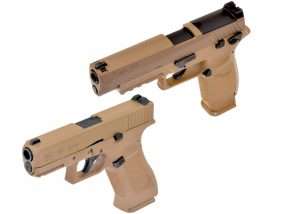
Cost v. Performance
Cost of guns and ammunition is a primary factor in many arms purchases (especially at the government level). As it relates to air pistols the differences for individual guns are measured in tens of dollars not hundreds of dollars (multiplied exponentially by the size of the government order, we are talking millions of dollars). But everything is commensurate when an individual is laying out hard cash, so the difference in price between an M17 CO2 model and, for a fair comparison, the G17 Third Gen and G19X, is around $99 compared to the Sig at $119. A difference of twenty bucks really isn’t going to influence that many buying decisions, as much as the difference in pellets vs. BBs and the cost of extra magazines. Here Sig’s M17 gives a big break with complete spare mags selling for around $20, while the Glock mags for the Third Gen and G19X are the same and sell for around $30. The Gen4 CO2 BB mags are even more expensive at around $48.
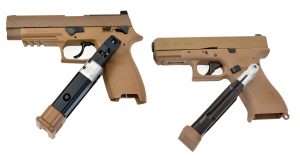
As to the price of pellets vs. BBs, it depends upon the quality of pellet you use; very affordable RWS Hobby 4.5mm lead wadcutters, for example, sell for as little as $6.29 for 300 count tins, while a personal favorite of mine, RWS Meisterkugeln Professional Line 7.0 gr. lead wadcutters cost $12.95 for a 500 count tin. BBs, on the other hand, like Umarex Precision steel BBs, sell for as little as $3.95 for a bottle of 1500. No surprise that BBs are less expensive. You pay less for the Sig’s CO2 pellet magazine (at the current price), but there is no way that the cost of pellets can be competitive with BBs, so blowback action BB models will always have that advantage. But that, too, comes at a price, or usually does.
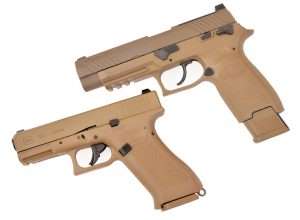
The rule of thumb has always been that BBs are good with blowback action CO2 models to an optimum accuracy range of 21 feet (7 yards), which is ideal since that is one of the standard handgun training distances for centerfire pistols: 7 yards, 10 yards, 15 yards, and 25 yards. Where the rules change is with the Third Gen and G19X Glock CO2 models, which have consistently proven to generate sufficient velocity to make these blowback action BB models accurate for training use out to 10 yards and competitive with blowback action pellet pistols.
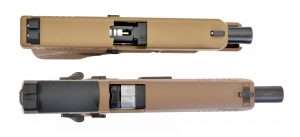
Since neither the Glock 19X nor the Sig M17 fieldstrip (yes, you can takes the M17 apart but it is not the same as field stripping the centerfire model), aside from what they fire, the G19X is a fair comparison to the M17. Technically, the G17 Third Gen CO2 model is an even match for size, but the G19X is a sharper looking gun for the same price and in the 9mm military models the compact Sig Sauer M18 is the same approximate size as a Glock 19X. And that brings us to comparing the G19X with the M17 on a pretty level playing field.

This is something you don’t expect in a blowback action CO2 BB pistol, velocities that are comparable to a CO2 pellet pistol. Of course, neither of these are your run of the mill BB or pellet pistols, the Sig M17 ASP is the only blowback action air pistol with a self-contained CO2 pellet magazine and the Glock 19X is one of only two blowback action BB pistols with self-contained CO2 BB magazines that consistently send .177 caliber steel BBs downrange at well over 350 fps. This makes the Glock 19X (and Third Gen Glock 17) capable of shooting at the same distances and with comparable accuracy to a pellet firing semi-auto pistol. The operative word here is “capable.” But is the Glock actually going to rival the M17 ASP?
Speed & Accuracy
Let’s begin by reviewing the average velocities from the M17 ASP using Sig Sauer 5.25 gr. Match Ballistic alloy wadcutters, and the G19X with 5.1 gr. Umarex steel BBs. The Sig shooting Sig averages 358 fps. The Umarex G19X shooting Umarex averages 376 fps (significantly greater than other blowback action CO2 pistols).
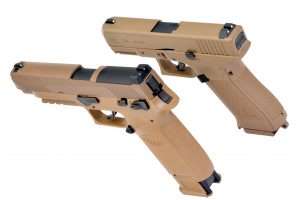
Taking into consideration the 0.15 gr. weight advantage for the BBs over alloy pellets, versus the advantage of a rifled steel barrel and wadcutter pellets, it’s almost a wash when you realize there’s only an 18 fps variation in average velocity, which makes these two pretty darn close to equal. What will make the important difference is how well the Glock’s smoothbore barrel can deliver tight groups against the Sig’s rifled barrel at the 10 yard training distance.
In terms of handling, I have found the slightly larger and brighter white dot sights on the G19X to be easier to put on target, despite the shorter overall sight radius, (6.5 inches for the Sig and 6.0 inches for the G19X). The Glock sights are also closer to POA/POI with a 6 o’clock hold than the Sig, which hits just a little below of POA at 10 meters. We are only talking slight POI corrections for either gun.

While this next part is truly subjective, being based on an individual’s preferences for grip design, the grip angle on the M17 and G19X are almost identical, however, the Sig has a much wider grip than the Glock, and that is what makes one more comfortable than the other, depending upon the user. The Glock 19X, which has the small backstrap as standard, is a little more comfortable and secure in my hands than the M17, but again, that’s me. The centerfire M17 was designed to be suitable to a variety of hand sizes by changing frames, while the Glock Gen5-based G19X changes backstrap panels (however, not on the CO2 models).
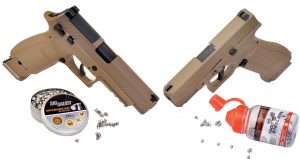
Slinging Alloy & Steel at 10 Yards
This is the final proof of the G19X against the M17 ASP. The Sig delivered a best 10 rounds at 1.68 inches, with five shots closely grouped at 0.875 inches. This was the best of five targets which averaged between 1.68 inches to 1.75 inches for 10 shots fired at 1-second intervals using a Weaver stance and two-handed hold. The Sig’s slide has a decent sense of recoil, though not as snappy as the Glock 19X. None of my tests with the M17 have shown overly impressive accuracy, which would be 1-inch or smaller groups. The best 10-shot group from 10 yards with the Umarex Glock was no better, with a best spread of 1.8 inches and a five-shot group clustered into 0.93 inches. The Glock is, however, more consistent from shot to shot, and while I was not trying to shoot paired groups the gun did, in fact, group all but two rounds into pairs.
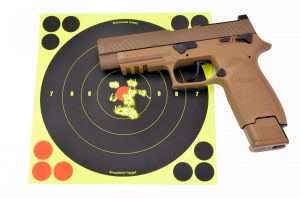
Conclusions
The M17 is not a target pistol and neither is the G19X, but for training guns and general shooting accuracy, the BB pistol is just about an equal match to the pellet pistol; one does not have a clear advantage over the other except that BBs cost less than pellets, and the G19X magazines fit standard 9mm Glock 17 mag pouches.
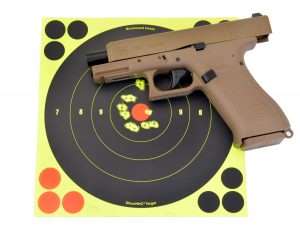
For 1:1 training, both CO2 semi-autos are good choices, the M17 if you have a 9mm M17 or P320, and the G19X if you own any Glock, period. And that’s still the key factor with Umarex Glock models. If you like Glocks, buy the Glock 19X. The difference in velocity and accuracy at training distances of 7 yards to 10 yards is negligible, making this one time where pellets don’t beat BBs. And you can thank Umarex and Glock for that achievement.
A word about safety
Blowback action airguns provide the look, feel and operation of their cartridge-firing counterparts and this is one reason why they have become so popular. Airguns in general all look like guns, blowback action models more so, and it is important to remember that the vast majority of people can’t tell an airgun from a cartridge gun. Never brandish an airgun in public. Always, and I can never stress this enough, always treat an airgun as you would a cartridge gun. The same manual of operation and safety should always apply.


The Glock looks more comfortable for the hand…